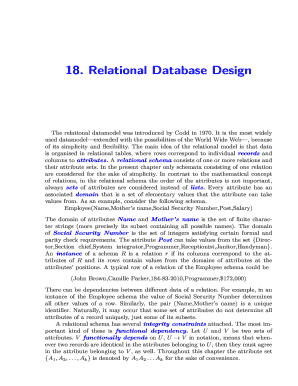
Relational Database Design the Relational Datamodel Was Introduced by Codd in 1970 Form


Understanding Relational Database Design
The relational database design is a systematic approach to organizing data in a way that allows for efficient retrieval and manipulation. Introduced by Edgar F. Codd in 1970, this model structures data into tables, which are also known as relations. Each table consists of rows and columns, where rows represent individual records and columns represent attributes of those records. This design promotes data integrity and minimizes redundancy, making it easier for businesses to manage their information effectively.
Key Elements of Relational Database Design
Several fundamental components define relational database design:
- Tables: The core structure where data is stored, each table corresponds to a specific entity.
- Primary Keys: Unique identifiers for each record in a table, ensuring that no two rows are identical.
- Foreign Keys: References to primary keys in other tables, establishing relationships between different datasets.
- Normalization: The process of organizing data to reduce redundancy and improve data integrity through various normal forms.
Steps to Implement Relational Database Design
To create an effective relational database, follow these steps:
- Identify the data requirements and define the entities and relationships.
- Create tables for each entity, ensuring that each table has a primary key.
- Establish foreign keys to link tables, reflecting the relationships between entities.
- Normalize the database to eliminate redundancy and ensure data integrity.
- Test the database design by inserting sample data and running queries to validate functionality.
Examples of Relational Database Applications
Relational databases are widely used across various industries. Common applications include:
- Customer Relationship Management (CRM): Managing customer data and interactions.
- Inventory Management: Tracking product stock levels and supplier information.
- Financial Systems: Handling transactions, accounts, and reporting.
- Human Resources: Managing employee records, payroll, and benefits.
Legal Considerations in Relational Database Design
When designing a relational database, it is essential to consider legal compliance, especially regarding data protection laws. In the United States, businesses must adhere to regulations such as:
- Health Insurance Portability and Accountability Act (HIPAA): Protects sensitive patient health information.
- General Data Protection Regulation (GDPR): Applies to businesses handling data of EU citizens, affecting U.S. companies with international operations.
- California Consumer Privacy Act (CCPA): Grants California residents rights regarding their personal information.
Obtaining Resources for Relational Database Design
To effectively implement relational database design, various resources are available:
- Online Courses: Many platforms offer courses on database design principles and practices.
- Books: Numerous texts provide in-depth knowledge on database theory and practical applications.
- Community Forums: Engaging with online communities can provide insights and support from experienced professionals.
Quick guide on how to complete relational database design the relational datamodel was introduced by codd in 1970
Effortlessly Complete [SKS] on Any Device
Digital document management has gained popularity among both organizations and individuals. It offers a great environmentally friendly substitute for traditional printed and signed documents, allowing you to obtain the correct form and securely save it online. airSlate SignNow equips you with all the necessary tools to create, modify, and electronically sign your documents quickly without delays. Manage [SKS] on any platform with the airSlate SignNow Android or iOS applications and simplify your document-related tasks today.
The easiest method to modify and electronically sign [SKS] effortlessly
- Obtain [SKS] and click Get Form to initiate.
- Utilize the tools we offer to complete your document.
- Emphasize important sections of your documents or obscure sensitive information using tools that airSlate SignNow specifically provides for that purpose.
- Generate your electronic signature with the Sign tool, which takes moments and holds the same legal validity as a conventional wet ink signature.
- Review all the details and click on the Done button to save your changes.
- Select how you wish to send your form, via email, text message (SMS), invite link, or download it to your computer.
Say goodbye to lost or misplaced documents, tedious form searches, or errors that necessitate printing new copies. airSlate SignNow fulfills all your document management needs in just a few clicks from any device you prefer. Modify and electronically sign [SKS] and guarantee excellent communication at any stage of the document preparation process with airSlate SignNow.
Create this form in 5 minutes or less
Related searches to Relational Database Design The Relational Datamodel Was Introduced By Codd In 1970
Create this form in 5 minutes!
How to create an eSignature for the relational database design the relational datamodel was introduced by codd in 1970
How to create an electronic signature for a PDF online
How to create an electronic signature for a PDF in Google Chrome
How to create an e-signature for signing PDFs in Gmail
How to create an e-signature right from your smartphone
How to create an e-signature for a PDF on iOS
How to create an e-signature for a PDF on Android
People also ask
-
What is Relational Database Design and how does it relate to airSlate SignNow?
Relational Database Design is a method of structuring data introduced by Codd in 1970, which allows for efficient data management. airSlate SignNow utilizes this design to ensure that document management and eSigning processes are streamlined and organized, making it easier for businesses to manage their documents.
-
How does airSlate SignNow enhance the efficiency of Relational Database Design?
airSlate SignNow enhances the efficiency of Relational Database Design by providing a user-friendly interface that simplifies document workflows. By leveraging the principles of the relational datamodel, businesses can easily track and manage their documents, ensuring that all data is accurately represented and accessible.
-
What are the pricing options for airSlate SignNow?
airSlate SignNow offers flexible pricing plans designed to accommodate businesses of all sizes. Each plan provides access to features that support Relational Database Design, ensuring that users can effectively manage their documents without breaking the bank.
-
What features does airSlate SignNow offer for document management?
airSlate SignNow includes features such as eSigning, document templates, and automated workflows, all of which are built on the principles of Relational Database Design. These features help businesses streamline their document processes, making it easier to manage and retrieve important information.
-
Can airSlate SignNow integrate with other software solutions?
Yes, airSlate SignNow offers integrations with various software solutions, enhancing its functionality. By integrating with tools that support Relational Database Design, businesses can create a seamless workflow that improves data management and document handling.
-
What are the benefits of using airSlate SignNow for eSigning?
Using airSlate SignNow for eSigning provides numerous benefits, including increased efficiency and reduced turnaround times. The platform's foundation in Relational Database Design ensures that all signed documents are securely stored and easily retrievable, enhancing overall business productivity.
-
Is airSlate SignNow suitable for small businesses?
Absolutely! airSlate SignNow is designed to be cost-effective and user-friendly, making it an ideal solution for small businesses. By utilizing Relational Database Design, small businesses can manage their documents efficiently without the need for extensive IT resources.
Get more for Relational Database Design The Relational Datamodel Was Introduced By Codd In 1970
Find out other Relational Database Design The Relational Datamodel Was Introduced By Codd In 1970
- eSignature Life Sciences Word Hawaii Free
- eSignature Life Sciences Word Hawaii Secure
- eSignature Minnesota Lawers Living Will Now
- eSignature Life Sciences Word Hawaii Fast
- eSignature Life Sciences PDF Georgia Free
- eSignature Life Sciences Word Hawaii Simple
- eSignature Life Sciences Word Hawaii Easy
- eSignature Life Sciences Word Hawaii Safe
- eSignature Life Sciences PDF Georgia Secure
- eSignature Minnesota Lawers Living Will Later
- eSignature Life Sciences PDF Georgia Fast
- eSignature Minnesota Lawers Living Will Myself
- How To eSignature Minnesota Lawers Living Will
- eSignature Life Sciences PDF Georgia Simple
- How Do I eSignature Minnesota Lawers Living Will
- Help Me With eSignature Minnesota Lawers Living Will
- How Can I eSignature Minnesota Lawers Living Will
- eSignature Minnesota Lawers Living Will Free
- eSignature Life Sciences PDF Georgia Easy
- eSignature Life Sciences PDF Georgia Safe